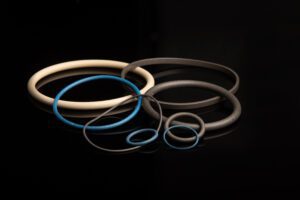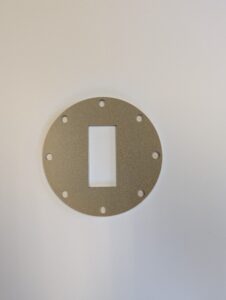SSP’s corrosion resistant EMI gasket material is an offset to Chomerics CHO-SEAL 6502.
Specialty Silicone Products (SSP) now offers a nickel-aluminum silicone for marine gaskets that require galvanic-corrosion resistance and MIL-DTL-83528F EMI shielding. SSP’s new product, SSP-2529, is an offset to Chomerics 6502 that features shorter lead times and lower minimum order quantities (MOQs) than the competition.
SSP-2529 is a dark gray, 68-durometer EMI silicone that’s supplied as molded sheets and extruded profiles. This nickel-aluminum product was tested for galvanic corrosion using a salt spray apparatus operated in accordance with ASTM B117. SSP-2529 was also tested for shielding effectiveness (dB) by a third-party, MIL-DTL-83528 certified laboratory. A new SSP white paper provides details and is available upon request..
Galvanic Corrosion-Resistant EMI Gasket Material
Galvanic corrosion is the most common corrosion-related condition to affect EMI gaskets. Known as “dissimilar metal corrosion”, this electrochemical process occurs when:
There are two different metals that can generate a voltage.
The metals are joined electrically by a current path.
The metals are immersed in a fluid that can dissolve one the metals
Typically, EMI gaskets are installed between flanges that contain different metals than the gasket itself. Most flanges are made of aluminum or steel, but many EMI gaskets contain silver, nickel, Monel, or other metals. EMI gaskets are electrically conductive, too. In environments with salt spray, salt water, or atmospheric humidity, fluids collect at the flange-gasket interface to provide the electrolyte.
In its new white paper, SSP explains how nickel-aluminum filled silicones exhibit the lowest amount of flange pitting from galvanic corrosion associated. Nickel-aluminum silicones also exhibit excellent galvanic stability with aluminum flanges.
Weight Loss %, Material Properties, and Shielding Effectiveness
As SSP’s white papers explains, galvanic-corrosion testing involved 168 hours of salt spray exposure at 95° F. The material under test was aluminum 6081 with a chromate conversion coating per MIL-DTL-5541F, Type II, Class 1A and 3. The weight loss of the aluminum sample was only 0.08%. Complete material specifications, including the other ASTM test methods that were used, are available.
SSP-2529 was also tested by D.L.S. Electronic Systems, Inc., a third-party, MIL-DTL-83528 certified laboratory in Wheeling, Illinois specializing in electromagnetic compatibility (EMC) and product safety testing. During product testing, a material sample was subjected to controlled compression at 10%. The minimum attenuation level was 93 dB at 10 GHz and the best-case attenuation level was 135 dB at 80 MHz. The complete test results for SSP-2529 are available.
Get the White Paper
Engineers and buyers who would like to learn more about SSP-2520 are invited to contact SSP on-line, or email Dominic Testo to request SSP’s new white paper.





